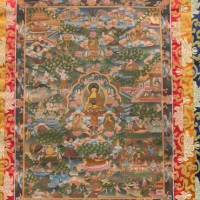
Vibrant in the richness of their colour, and divine in the blessings they confer on their surroundings, thangkas carry the same divine energies as Buddha statues, depicting the stunning figures of Buddhist deities.
Developed under the influence of Buddhist art from India, Nepal, Bhutan and Tibet, thangkas were conceived as a more efficient way for Tibetan nomads to transport and keep the divine with them, as statues were too bulky.
In this way, thangkas remain unique and sacred as an art form developed purely for the sake of spirituality and religion. Even the Dalai Lama is known to have carried a thangka of the Dharma protector Palden Lhamo.
From then, thangkas have been developed as objects of religious devotion or as the basis for meditation. Today, the versatility of the thangka has been readapted to suit contemporary aesthetics, while maintaining the sacredness of its spiritual tradition.
Often, thangkas are regarded as graphic scriptures, and are complimentary to written scriptures, for within the painting lies the full instructions and path towards Enlightenment. Just as all Buddha images are considered holy objects, thangkas too confer blessings upon its surroundings and the people within, whether they are kept as devotional religious objects or simply as inspiring, vivid artwork.
The images of Buddhist deities depicted in thangkas – as representations of the enlightened mind – originate from mystical visions or recorded on texts by great enlightened masters. Thus, geometric dimensions and measurements of the painted Buddhas remain exact and intricately detailed, and are meticulously adhered to by artists, even until today.
In fact, the act of painting is regarded as a spiritual practice in itself and completed with the strong motivation to bring benefit to others, not as a means of making money or for the sake of exploring artistic boundaries. In this way, much of the artist’s own personal spiritual connection to what he is painting is brought forward, imbuing the thangka with an energy that goes beyond the canvas.








